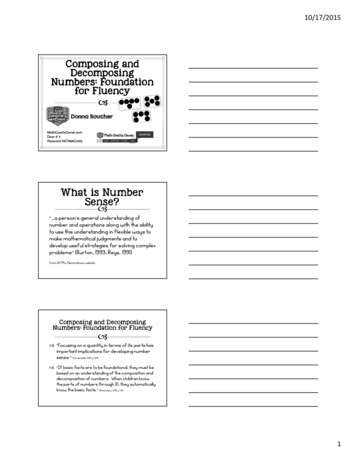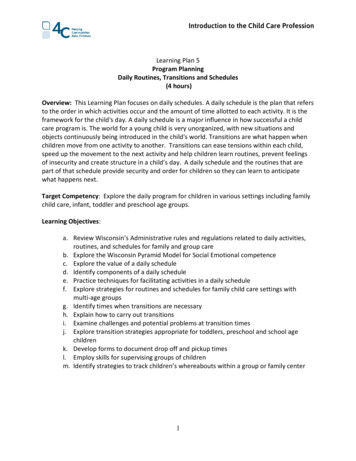
Transcription
10/17/2015MathCoachsCorner.comDoor # 3Password NCTMAC2015What is NumberSense? “ a person's general understanding ofnumber and operations along with the abilityto use this understanding in flexible ways tomake mathematical judgments and todevelop useful strategies for solving complexproblems” (Burton, 1993; Reys, 1991)from NCTM’s Illuminations websiteComposing and DecomposingNumbers: Foundation for Fluency “Focusing on a quantity in terms of its parts hasimportant implications for developing numbersense.” (Van de Walle, 2013, p 139) “If basic facts are to be foundational, they must bebased on an understanding of the composition anddecomposition of numbers. When children knowthe parts of numbers through 10, they automaticallyknow the basic facts.” (Richardson, 2012, p 43)1
10/17/2015Number Bonds: Fact FamiliesRevisited Number bonds emphasize the part/part/wholerelationship the relationship betweenaddition and subtractionThe Evolution of a NumberBond Add and subtract within 20Add and subtract within 100The Evolution of a NumberBond Fourth GradeElapsed timeFifth GradeMeasurement conversionsFourth GradeAdd fractions2
10/17/2015What is Subitizing? Talk about it!Dot Cards “Incorporating dotimages into classroomnumber talks providesopportunities to work oncounting, seeingnumbers in a variety ofways, subitizing, andlearning combinations.”(Parrish, 2012, p 41)Door #3Dot CardRoutines Develop and practiceprocedures for dot cardroutines. Avoid having studentsshout out answers. Be sure to ask not only whatnumber they see, but also howthey see it. “Did anyone see it a differentway?”Let’s try it!3
10/17/2015Dot CardRoutines Start with smaller numbers and build tolarger numbers that use combinationsof the smaller numbers.Dot CardRoutines Connect the visual to the symbolic by writingnumber sentences for the combinationsstudents see.3 3 63 2 1 64 2 65 1 6Dot CardRoutines 5- and 10-frames anchor to the criticalbenchmarks of 5 and 10.4
10/17/2015Dot CardRoutines The process is the same as with random dotcards, but questioning can include therelationship of the number shown to 5 or 10.Dot CardRoutines Use two colors to supportcomposing/decomposing skills anddevelopment of basic facts.Dot Card InteractiveResources NCTM Illuminations, fiveand ten-frame tools Fuel the Brain, # Flash5
10/17/2015Dot Card InteractiveResources DreamBox, Numbers to 10on the Ten-FrameDifferentiating—What’s My Number? Building a number (composing) and breaking a numberapart (decomposing) Use the “hiding assessment” to determine each child’snumber Students should master the combinations for one numberbefore moving on to the next Independent practice, partner work, and small-groupinstruction are all based on each student’s number Ongoing as in ALL YEAR LONGDifferentiating—What’s My Number? Door #36
10/17/2015NumberBracelets Use chenille stems(cut off about 2”) andpony beads to makebracelets. Use asingle color for thebeads. Use mailinglabels for the numbertag. Put the numbertag over the twistedends.Door #3Number BraceletRoutines Students manipulate the beads and make all thecombinations for a given target number.Let’s try it!Number BraceletRoutines Students can record their numbercombinations in a math journal to connect theconcrete with the abstract (symbolic).7
10/17/2015Number BraceletRoutines Partner activity—onepartner hides somebeads and the otherpartner has to figure outhow many are hidden. Number bracelets aregreat for the “hidingassessment”.Rekenreks Rekenrek translatesloosely to calculation rackor arithmetic rack, and itwas designed by a DutchMathematician. Therekenrek is a great visualmodel for developing astrong sense of 5 and 10,and it supports astrategy-basedapproach for learningcalculations.Rekenreks Cut foam sheets into 4 x 6 rectangles Cut 2” off the ends of the chenille stems Poke the ends of the chenille stems into left side ofthe foam rectangle, about an inch apart Thread 5 red beads and 5 white beads on eachstem Poke the other ends of the stems through the foamand twist the ends together on the back8
10/17/2015Rekenrek Routines Introduce the rekenrek and allow students to makeobservations. Teach the conventions of starting with the beads onthe right and move beads in groups, rather thanone by one.Rekenrek Routines Quick FlashMake 5—top row only; top and bottomMake 10—tip row only; top and bottomBuild a Number—partnersNumbers from 11-20—how many tens and ones?“Use the top row toshow me 3 with onemove.”Rekenrek InteractiveResources Professor Garfield, WhatDo I See and Push to Make DreamBox, Numbers to 10on the Math Rack9
10/17/2015Shake and SpillDifferentiate by changing the targetnumberShake and Spill3 on the duck and 4off the duck.3 and 4 make 7.5 on the duck and 2off the duck.5 and 2 make 7.Door #3How Many to Make Ten? Materials: blank ten-frame, two-color counters,10-sided die (0-9) Roll the die and put that number of counters on the tenframe using one color Use the other color to complete the ten-frame State the number sentence or combination6 and 4 make 10or6 4 10or10 6 4Door #310
10/17/2015Roll and Cover Materials: game board, two-color counters, 10-sideddice (0-9) Roll the dice and determine the number needed to make10; cover that number on the board Players take turns rolling and covering numbers until allnumbers are coveredDoor #3Seven on Top Lay out seven cards face upRemove pairs of cards with a sum of 10Replace cards, always leaving sevenIf there are no pairs for ten in the sevencards showing, lay down another sevencards on top of the others Variations: Show cards one at a time and havestudents tell you the number thatmakes ten Remove some cards and playlooking for combinations of othernumbers Mathemagician Make Ten Remove the face cards and Jokers from astandard deck of playing cards; aces are ones One player chooses a card from the deck andplaces it face down off to the side Place all other cards face up in rows andcolumns on the table Taking turns, players take pairs of cards thatcombine to make 10 off the table while stating thefact; 10s can be taken off the table, and theplayer would say 10 0 At the end of the game, one card will be left onthe table; its pair is the one hidden off to the side!Note: if no cards are left on the table at the endof the game, the hidden card is a 10! Let’s try it!11
10/17/2015References Van de Walle, John A. (2013). Elementary and Middle School Mathematics:Teaching Developmentally. Boston: Pearson Education. Baroody, A.J. (1987). Children’s mathematical thinking: A developmentalframework for preschool, primary, and special education teachers. NewYork: Teachers College Press. Parrish, Sherry. (2010). Number Talks: Helping Children Build Mental Math andComputation Strategies, Grades K-5. Sausalito, CA: Math Solutions. Richardson, Kathy. (2012). How Children Learn Number Concepts: A Guide tothe Critical Learning Phases. Bellingham, WA: Math Perspectives. The Math Learning Center. (2008). Using the Rekenrek as a Visual Model forStrategic Reasoning in Mathematics. Salem, OR: Authors.Online Resources NCTM yDetail.aspx?ID 74, five-frame spx?ID 75, ten-frame tool Fuel the Brain, Interactives, # php?ID 29 DreamBox Teacher Tools, http://www.dreambox.com/teachertools Professor e/math.html DreamBox Teacher Tools, http://www.dreambox.com/teachertools12
Number Bracelets Door #3 Use chenille stems (cut off about 2") and pony beads to make bracelets. Use a single color for the beads. Use mailing labels for the number tag. Put the number tag over the twisted ends. Students manipulate the beads and make all the combinations for a given target number. Number Bracelet Routines Let's try it!










